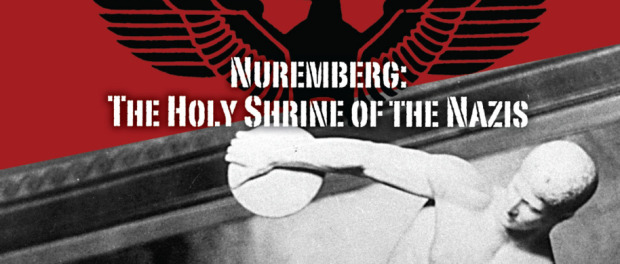Nuremberg Nazis : DVD Review of Fuhrer Cult and Megalomania
Countless feature films and documentaries have been made about World War II. The newly released DVD by First Run Features, Fuhrer Cult and Megalomania (Michael Kloft) focuses on the importance of the city of Nuremberg in regard to its role in promoting and showcasing Hitler and the Nazi Party. Indeed, in the years before the war Nuremberg was perceived to be the most anti-Semitic city in Europe and served as the rallying grounds for the Nazi movement. The German city rose to prominence in 1934 when it hosted the Nazi Party Congress. This massive event was famously documented by filmmaker Leni Riefenstal in her 1935 propaganda film Triumph of the Will. The rally was meticulously planned and coordinated as a means to showcase the political power of Hitler’s Nazis. The event was attended by some 700,000 soldiers and civilians and was used to demonstrate to the rest of the world that the political atmosphere of Germany had radically changed and was now firmly under Nazi Party rule.
Fuhrer Cult and Megalomania explores Nuremberg in terms of its status as a site designed to be a timeless shine to Hitler and the Nazis. It’s a well-known fact that Hitler was deeply passionate about architecture and assumed a leading role in designing and erecting a number of grandiose architectural projects. Along with Albert Speer, the Nazi leader planned to create a number of monuments that would endure for all time and thus symbolize the glory of his rule over the German people. During the film Hitler is even quoted as saying, “I am building for eternity for we are the last Germany.”
The documentary traces the development of the so-called “holy shrine of the Nazis” from its initial planning stages to construction, it’s role as a Nazi showpiece, the invasion of Allied troops, it’s subsequent deterioration and post war use as a facility for concerts, etc., up until its present state as a crumbling landmark. It’s interesting to note that the original Nuremberg site included not only the Romanesque coliseum, but
a Zeppelin Field and memorial to the German soldiers who lost their lives during the First World War.
Fuhrer Cult and Megalomania is sure to appeal to World Ward II buffs, those interested in German history, as well as anyone with a keen knowledge of architecture. The film employs rare archival material as well as documentary footage, amateur color film, and present day interviews with a local historian as well as a former German soldier who actually attended the original Nazi Congress. Although the Congresses were portrayed to be well run, problem free, absent of discord, and presenting a unified German population loyal to Hitler and the anti-Semitic ideals of the Nazi regime the documentary Fuhrer Cult and Megalomania unearths a number of unflattering truths which run contrary to the positive images presented to the German public at the time.
One of the major themes in director Michael Kloft’s film is the important role propaganda played in maintaining political power and shaping popular opinion. The film demonstrates the consequences of political control of the media in regard to how news is presented to the general public. The Nazis made optimum use of propaganda and no where is this more evident than at the Party Congresses in Nuremberg.
Fuhrer Cult and Megalomania provides a clear and concise history of Nuremberg’s historical role as a Nazi shrine. The documentary also demonstrates the futility of human beings who try to attain immortality by erecting elaborate monuments as a means of symbolizing their power and achievements. Hitler yearned to build massive landmarks, much like the Egyptian pyramids, which would endure for all time and thus secure his place in history. Present day footage of the Nuremberg ruins proves that with time these monuments will eventually erode and be reclaimed by nature.
Furher Cult and Megalomania is available now from First Run Features.







